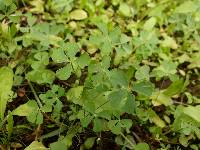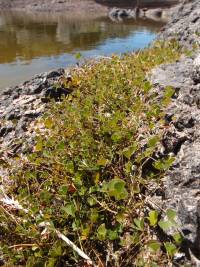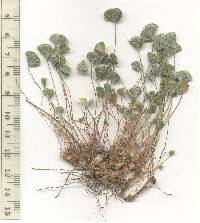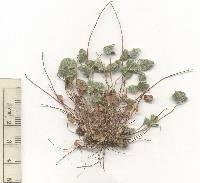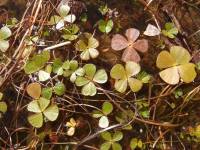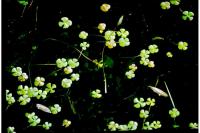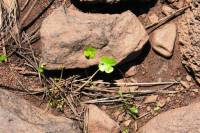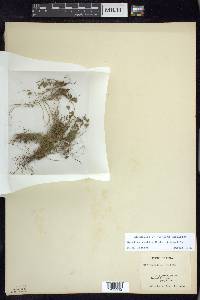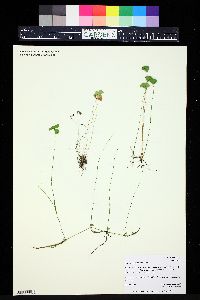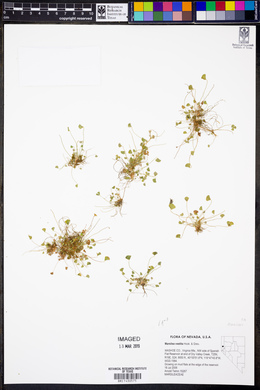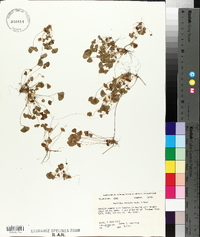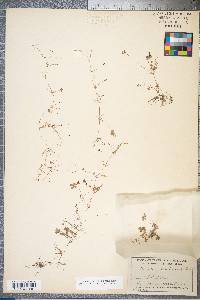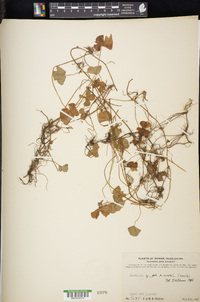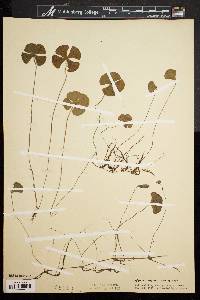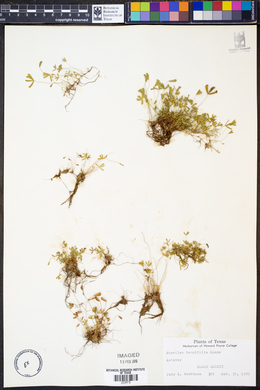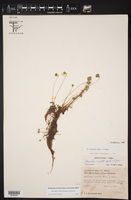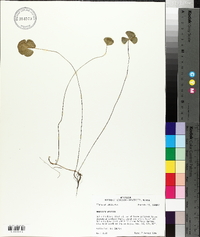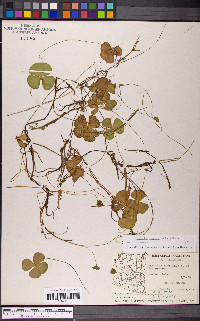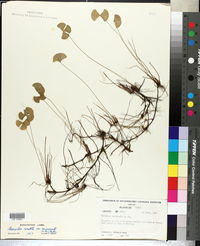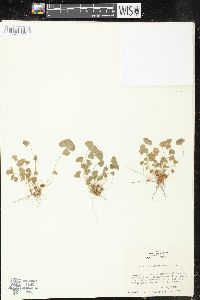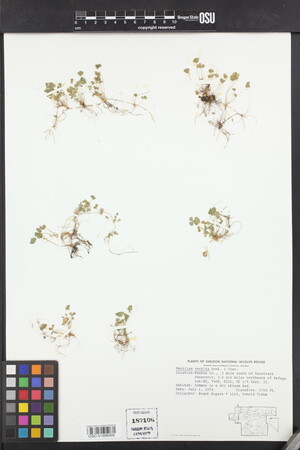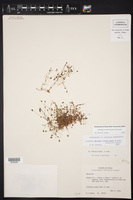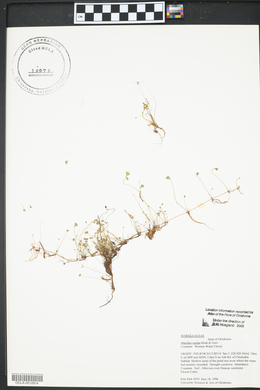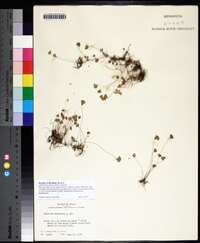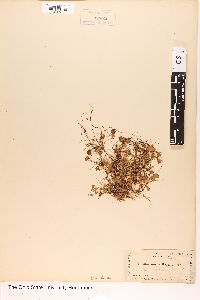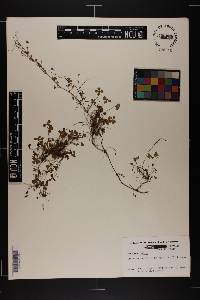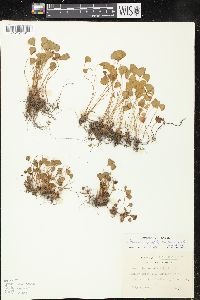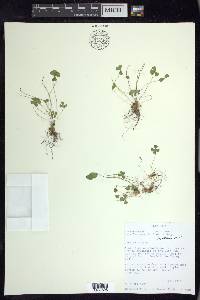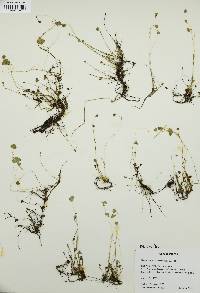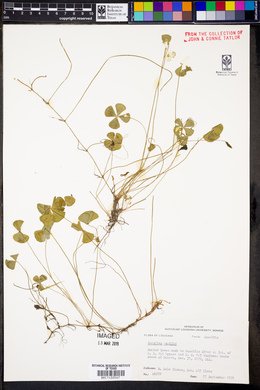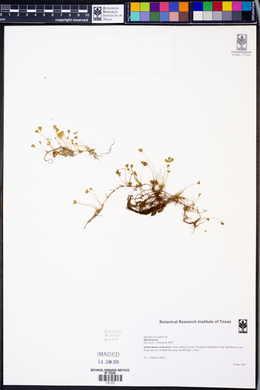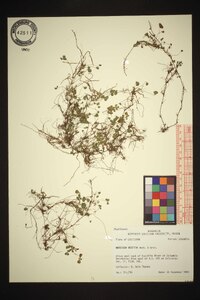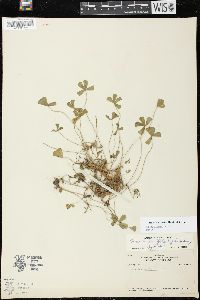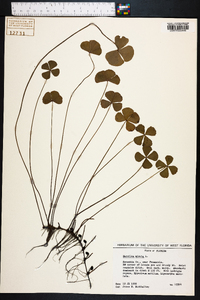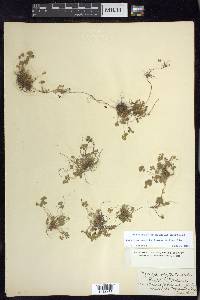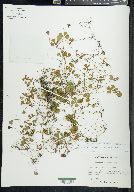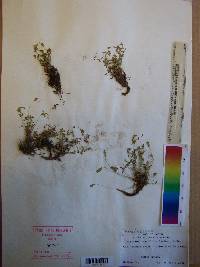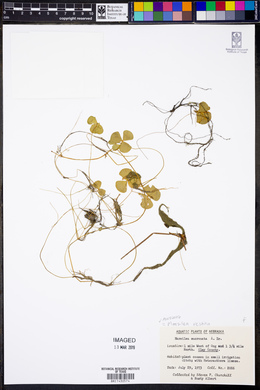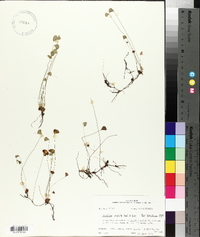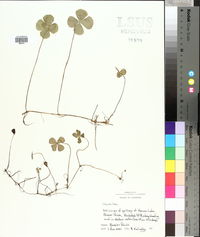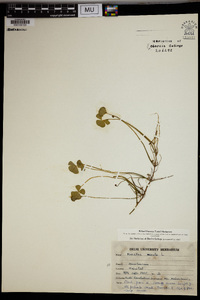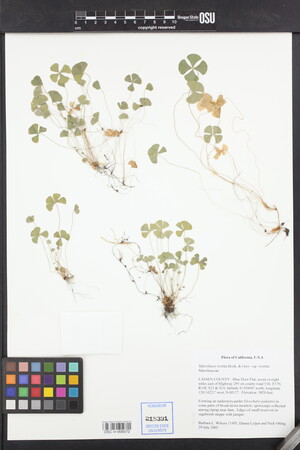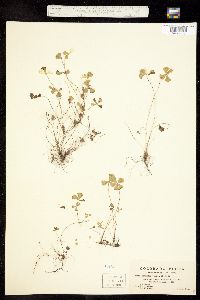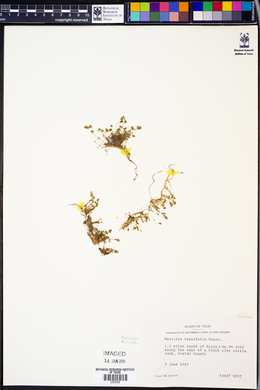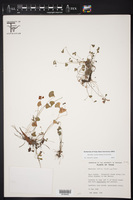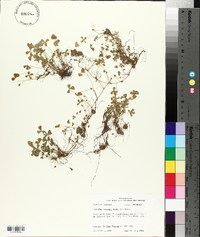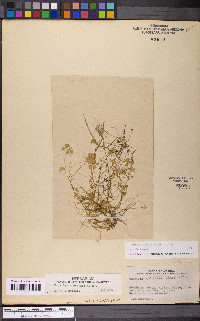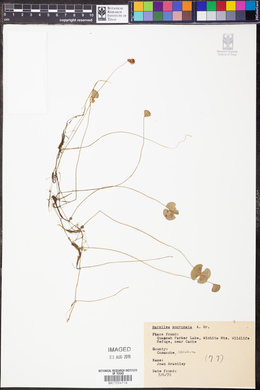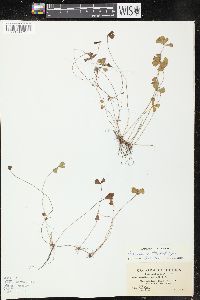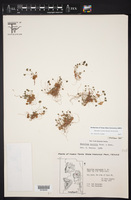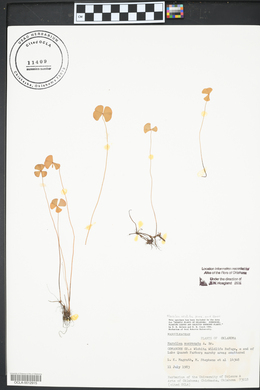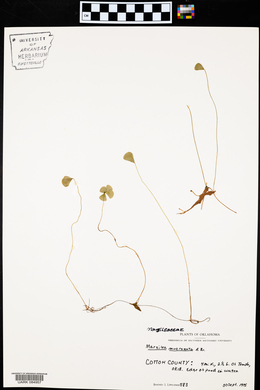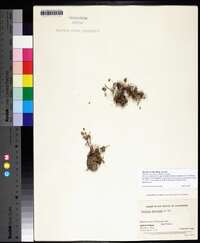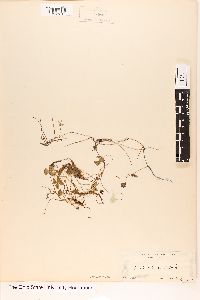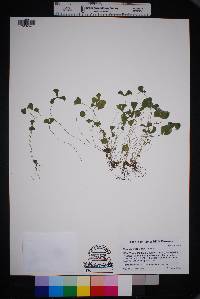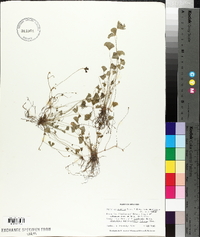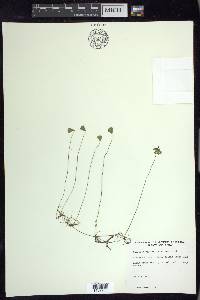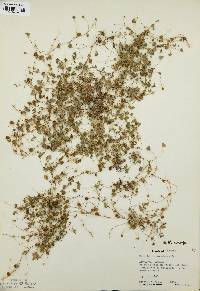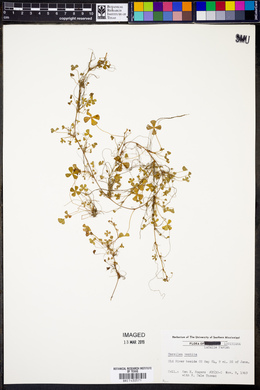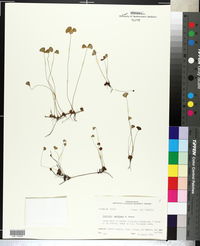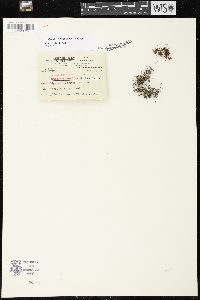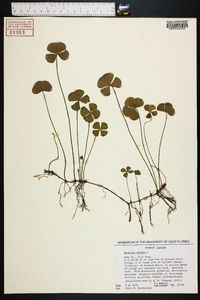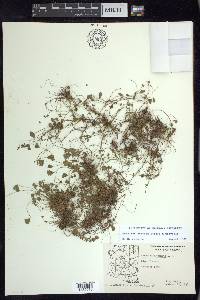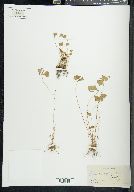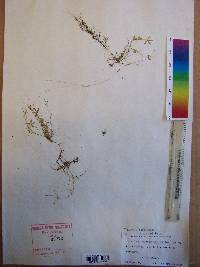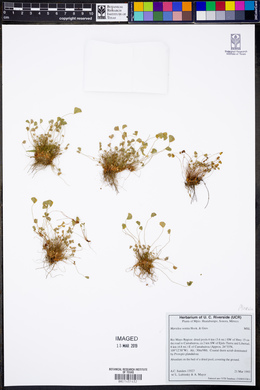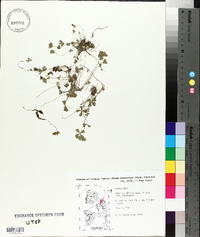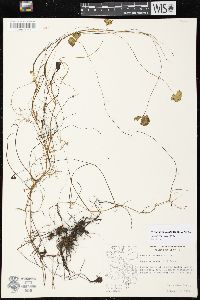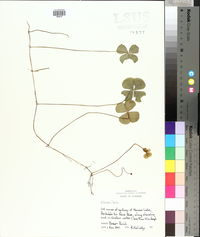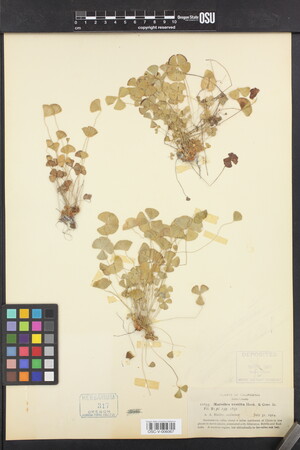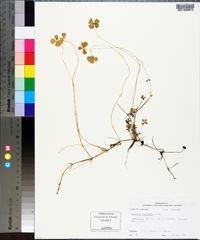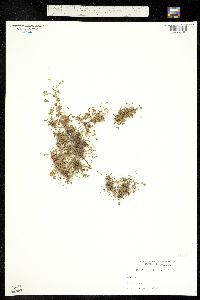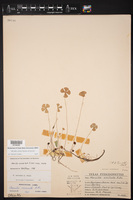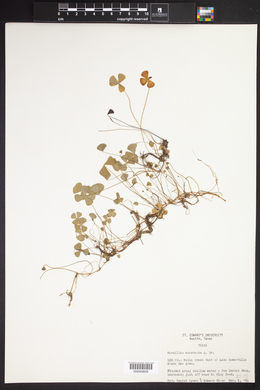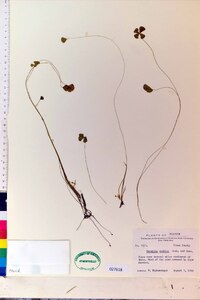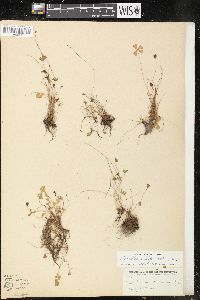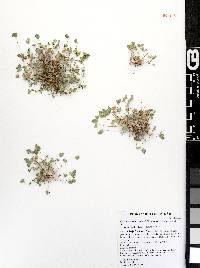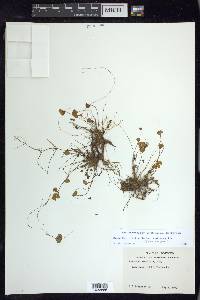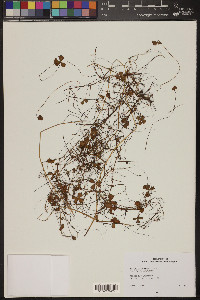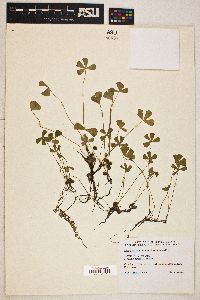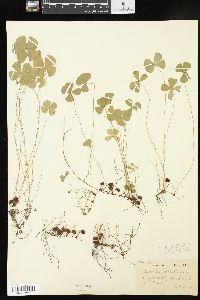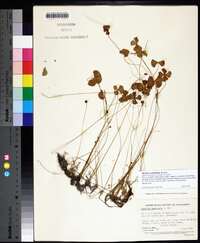Marsilea vestita
|
|
|
|
Family: Marsileaceae
Hairy Water-Clover, more...hairy waterclover, four-leaf clover fern, hairy pepperwort, water clover
[Marsilea longipes Austin, moreMarsilea tenuifolia Engelm.apud Kze., Marsilea vestita var. minima , Marsilea vestita var. tenuifolia (Engelm. ex A. Braun) Underw.] |
Plants forming diffuse or dense clones. Roots arising at nodes. Petioles 2--20 cm, sparsely pubescent. Pinnae 4--19 × 4--16 mm, pubescent to glabrous. Sporocarp stalks erect, unbranched, attached at base of petiole (occasionally up to 3 mm above it), not hooked at apex, 0.5--25 mm. Sporocarps perpendicular or slightly nodding, 3.6--7.6 × 3--6.5 mm, 1.5--2 mm thick, elliptic to nearly round in lateral view, pubescent but soon glabrate, scars left by fallen trichomes often appearing as purple or brown specks; raphe 1.1--1.7 mm, proximal tooth 0.3--0.6 mm, blunt, distal tooth 0.4--1.2 mm, acute, often hooked at apex. Sori 14--22. Sporocarps produced spring--fall (Apr--Oct). Widespread and variable; in ponds and wet depressions and on river floodplains; 0--2300 m; Alta., B.C., Sask.; Ariz., Ark., Calif., Colo., Idaho, Iowa, Kans., La., Minn., Mont., Nebr., Nev., N.Mex., N.Dak., Okla., Oreg., S.Dak., Tex., Utah, Wash., Wyo.; Mexico; South America in Peru. A number of segregate species have been named and recognized in regional floras in North America: Marsilea mucronata A. Braun (less hairy, found east of Rocky Mountains), M . uncinata (glabrous, sporocarp stalks long, distal tooth of sporocarp hooked, south central United States), M . tenuifolia (pinnae very narrow, central Texas), and M . fournieri (small plants and pinnae, southwest). The features upon which these species are based intergrade into one another. The species are therefore best treated as conspecific with M . vestita (D. M. Johnson 1986). Putative hybrids between Marsilea macropoda and this species are discussed under the former.
PETIOLES: 1-35 cm long, glabrous or sparsely appressed-hairy. LEAFLETS: 5-22 mm long, wedge-shaped to broadly wedge-shaped, broadly rounded to nearly truncate at the tips, often slightly asymmetrically cuneate, glabrous to more commonly moderately pilose on both surfaces, the lateral margins straight or more commonly 1 margin shallowly concave. SPOROCARPS: solitary, appearing more or less perpendicular to the peduncle produced from the tip of a short peduncle attached at or rarely just above the petiole base, (3.6-)4-7 mm long, 3-6 mm wide, oblong-quadrangular to broadly oval in outline, the tooth distal to the stalk tip well-developed, 0.4-1.2 mm long, sharply and narrowly triangular (Fig. 2B). MEGASPORES: 450-515 μm in diameter (excluding the apical papilla). MICROSPORES: 65-80 μm in diameter. 2n = 40. NOTES: Shallow water and margins of ponds, lakes, stock tanks, reservoirs, and streams: Cochise, Mohave, Pima, Pinal, Santa Cruz, Yuma cos. (Fig. 1B); 450-1650 m (1400-5400 ft); WA to MN, s to CA. REFERENCES: Windham, M. D. and G. Yatskievych. 2009. Vascular Plants of Arizona: Marsileaceae. CANOTIA 5 (1): 30-33. General: Aquatic perennial ferns, plants forming diffuse or dense clones, rhizomes branching and creeping at or just below the surface of the soil and rooting at the nodes. Leaves: Alternate, in 2 rows, generally clover-like, blades palmately divided into 4 pinnae, pinnae cuneate or obdeltate and mat-like at the base, 4-19 mm long and 4-16 mm wide, curling inwards or folded upwards at the tips at night and when in bud, surfaces pubescent to glabrous, frequently with numerous red or brown streaks abaxially in floating leaves, the veins dichotomously forked with frequent cross-veins, floating leaves averaging larger than land leaves, petioles filiform, stiffly erect or procumbent in land leaves, lax in floating leaves, 2-20 cm long, surfaces sparsely pubescent, leaves deciduous in temperate regions. Sporangia: Sporocarps perpendicular, slightly nodding, or axillary at the base of the leaves, 3.5-7.5 mm long, 3-6.5 mm wide and 1.5-2 mm thick, ovoid or elliptic to nearly round in lateral view, solitary, stalked, with thick walls, dehiscing into 2 valves, surfaces Ecology: Widespread and variable, found in ponds and wet depressions and on river floodplains, 1,500-7,500 ft (457-2286 m); sporocarps produced April-October. Notes: This little aquatic dweller looks like mats of floating 4-leaf clovers on the waters' surface. Etymology: Marsilea is named for the Italian soldier, botanist, geographer, and naturalist named Luigi Ferdinando, Count de Marsigli, 1658-1730, while vestita means covered, clothed, usually with hairs. Sources: FNA 1993, Yatskievych and Windham 2009, Kearney and Peebles 1969 FNA 1993, Yatskievych and Windham 2009, Kearney and Peebles 1969 Common Name: hairy waterclover Wetland Status: OBL General: Aquatic perennial ferns, plants forming diffuse or dense clones, rhizomes branching and creeping at or just below the surface of the soil and rooting at the nodes. Leaves: Alternate, in 2 rows, generally clover-like, blades palmately divided into 4 pinnae, pinnae cuneate or obdeltate and mat-like at the base, 4-19 mm long and 4-16 mm wide, curling inwards or folded upwards at the tips at night and when in bud, surfaces pubescent to glabrous, frequently with numerous red or brown streaks abaxially in floating leaves, the veins dichotomously forked with frequent cross-veins, floating leaves averaging larger than land leaves, petioles filiform, stiffly erect or procumbent in land leaves, lax in floating leaves, 2-20 cm long, surfaces sparsely pubescent, leaves deciduous in temperate regions. Sporangia: Sporocarps perpendicular, slightly nodding, or axillary at the base of the leaves, 3.5-7.5 mm long, 3-6.5 mm wide and 1.5-2 mm thick, ovoid or elliptic to nearly round in lateral view, solitary, stalked, with thick walls, dehiscing into 2 valves, surfaces Ecology: Widespread and variable, found in ponds and wet depressions and on river floodplains, 1,500-7,500 ft (457-2286 m); sporocarps produced April-October. Notes: This little aquatic dweller looks like mats of floating 4-leaf clovers on the waters' surface. Ethnobotany: Unknown. Etymology: Marsilea is named for the Italian soldier, botanist, geographer, and naturalist named Luigi Ferdinando, Count de Marsigli, 1658-1730, while vestita means covered, clothed, usually with hairs. Synonyms: Marsilea tenuifolia Editor: LCrumbacher2012 Rhizome rooting only at the nodes; lfls appressed- hairy on both sides, the emergent ones 5-20 נ5-15 mm, spatulate to flabellate, slightly oblique, at least the inner margin usually concave; peduncle 2-25 mm, usually unbranched, attached at or to 3 mm above the base of the petiole; sporocarp 3.5-7.5 נ3-6.5 mm, the inferior tooth 0.3-0.6 mm, the superior one 0.4-1.2 mm and often hooked; sori 14-22 per sporocarp, with 27-64 microsporangia and (2-)9-15 megasporangia per sorus. Cordilleran region of w. U.S. and adj. Can. and Mex., e. to Minn., Io., and La. (M. mucronata) Ours is the widespread var. vestita. Gleason, Henry A. & Cronquist, Arthur J. 1991. Manual of vascular plants of northeastern United States and adjacent Canada. lxxv + 910 pp. ©The New York Botanical Garden. All rights reserved. Used by permission. |
|
|
|


